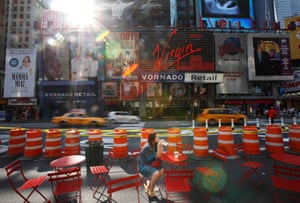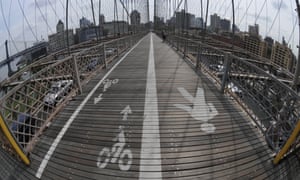That's the spirit!
Thanks to Mike for sending my way - I am glad you are on our team! He has requested a copy of the book below to be in the Nashville library!
Streetfighting woman: inside the story of how cycling changed New York
As transport commissioner, Janette Sadik-Khan faced down critics to transform New York with 400 miles of cycling routes, a bike share scheme and the remodelling of Times Square. Any city can do it, she tells Peter Walker
Janette Sadik-Khan, who in alliance with her then-boss, New York mayor Michael Bloomberg, arguably did as much to transform the city’s streetscape as anyone in its recent history, recalls an early moment when she wondered whether people were ready for such rapid change.
It was August 2008 and the city was experimenting with a so-called summer streets programme, where almost seven miles of central streets were closed off to cars for three Saturday mornings in a row. The idea was not new – Bogotá introduced its equivalent, the Cicloviá, in the 1970s – but it was entirely untested in New York.
“I remember, hours and hours before it opened, being out on the streets with my team and looking around, thinking, ‘What if no one shows up? What if this is a disaster?’,” said Sadik-Khan, who was Bloomberg’s transport commissioner from 2007 until he left office in 2013.
“I remember being truly relieved when I saw people walking and biking, and kids out there playing. It turned out New Yorkers knew exactly what to do with their streets. We had 300,000 people coming to play, and cha cha, and take basketball lessons.”
Sadik-Khan remains best known for the rapid rollout of around 400 miles of cycling routes during her six-and-a-half years in charge of the $2bn (£1.4bn) annual budget of New York City’s Department of Transportation, and the later opening of the Citi Bike cycle share scheme.
But in parallel she also oversaw a series of new rapid bus routes and the carving out of dozens of pedestrianised plazas from space previously reserved for cars, including the initially controversial remodelling of Times Square.
Sadik-Khan now advises other cities how to follow suit via the ex-mayor’s self-styled philanthropic consultancy, Bloomberg Associates. She has also condensed her vision into a book, Streetfight: Handbook for an Urban Revolution.
She describes the approach as re-writing “the operating code of the street”. It is a perhaps uncomfortable philosophy for those, like previous generations of New Yorkers, used to being able to drive and park their cars more or less where they choose.
Urban transport is, Sadik-Khan argues, amid a “Copernican revolution” in which streets are remodelled around human beings, whether walking, cycling or on buses, rather than alone inside a speeding metal box.
“In the United States we spent the last century building our cities around the car, but we damaged our cities in the process and were really getting diminishing returns on that investment,” she said.
“If city residents don’t have a choice but to drive everywhere then our cities don’t stand a chance of surviving in this century. So we really do need to provide new choices for people to get around. We need to face the fact that the way our streets are designed has, in the past, made the decision for its residents.”
The intention under Bloomberg, she says, was “kind of flipping the script in how our streets were designed and who are they designed for”.
Such a revolution was, inevitably, not without controversy. All sorts of local lobby groups battled plans for separated cycle lanes, most famously over one eventually built outside Brooklyn’s Prospect Park, a route once described as “the most controversial slab of cement outside the Gaza Strip”.
A good deal of the obloquy focused personally on Sadik-Kahn, even though her strategy came from Bloomberg’s PlaNYC, his 2007 vision for making an expanding city more green and liveable. But she came to exemplify his shift on cycling issues, which had seen little focus under his first transport commissioner, Iris Weinshall.
Some critics labelled Sadik-Khan “brusque” and uncompromising; others wondered whether such labels tend to stick more easily to the relatively rare women in positions of power.
“It’s fair to say that I grew a second skin over the course of six-and-a-half years,” she said. “There’s 8.4 million people in New York and I sometimes felt there were 8.4 million traffic engineers.
“People take their streets very personally. They treat every parking space like it was their first-born child. So it’s a fight. All 180 acres of streets that we gave back to people on foot and people on bikes and transit meant a hard-fought battle. I get it – transportation is local. People are passionate about their street, and when you talk about new ways to get around which aren’t about driving a lot of people really erupt.”
These days, she says with some justified satisfaction, polls show the changes are generally popular with New Yorkers. Other statistics are impressive, too.
Sadik-Khan’s old department produces a simple and illustrative graph plotting the changing risk of injury when cycling in New York against the number of cyclists doing it. From 2007 onwards the two lines diverge at steep angles. Even as cyclist numbers have more than doubled, the number of serious injuries has actually fallen.
Fittingly, as the employee of a billionaire entrepreneur, she sees such changes as not so much socially just as economically vital: “Transportation is not an ideology, it’s not a left or right thing. It’s about taking a look at the capital asset we have and using it in the most effective way possible.
“For so long the way we measured transportation, the way we measured our streets, had been about the flow of traffic, how fast was traffic going, which ignores all the other ways a street is used.
“Our streets have been in this kind if suspended animation. They’re seen as there for all time. The result is that you’ve got dangerous, congested, economically under-performing streets. That strikes at the heart of the liveability and competitiveness of a city.”
In her new role Sadik-Khan has advised cities including Rio de Janeiro, Los Angeles, Mexico City and Detroit. One of her key messages, she says, is that radical changes need not necessarily take a long time or a big budget, or even a mayor like Bloomberg.
“There’s no question having a strong leader does help in establishing that vision, and supporting change when the status quo blowback begins,” she said. “But in New York we fundamentally rewrote the operating code of the streets, not with mega-projects and billions of dollars, but by adapting the space that was already there.
“That’s a really important lesson in many, many cities: you don’t have to have the most visionary mayor, you don’t have to have a billion-dollar budget, you don’t have to have years and years of modelling. Just by adapting the space that’s there you can make a huge difference.
“A lot of cities are wary of trying things, as they’re afraid they might not work. But there’s a lot you can do with paint, and planters and stones from old bridge projects. We closed Broadway from Times Square in a few months using only the materials we had in the transportation department’s arsenal.
“You can change a street on a trial basis using materials that are easily adjusted or can be removed if it doesn’t work out. It’s available and it can be done.”
An example of this was the part-pedestrianisation of Times Square from 2009, achieved through the simple measure of blocking off Broadway with orange barrel-bollards. Even here, she recalls, there was space for last-minute improvisation.
“When we were closing Times Square, and we were rolling out the orange barrels, we looked out at this two football fields-worth of asphalt and thought, ‘Oh my God, that’s a lot of space, and there’s nothing there.’ And that’s what led to the beach chairs.’”
The near-400 folding chairs, bought from a local hardware shop for about $11 each when more permanent street furniture failed to arrive on time, showed the fundamental adaptability of New Yorkers, Sadik-Khan said.
“Again, the inspiration came out of necessity. But putting out those $11 beach chairs on Times Square was an interesting moment. People came out, and all people talked about was those chairs – the colour, the design. Not that we’d closed Times Square to cars.
“It was the same experience in so many of our projects: when you adapt the street, people adopt it. It’s almost like it’s always been there. You go to some of these plazas now and people have forgotten the way it used to be.”
Streetfight: Handbook for an Urban Revolution by Janette Sadik-Khan was published this week
LINK:
http://www.theguardian.com/cities/2016/mar/11/cycling-fights-new-york-mean-streets-janette-sadik-khan






No comments:
Post a Comment